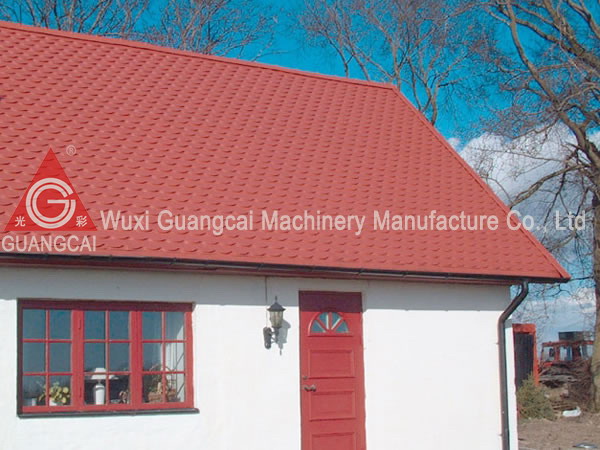Work Flow
Our glazed roof tile roll forming machine comprises of three parts which are roller table, profiling table and cutter table. The rollers rotate with the cycle chain that is driven by the motor to execute roll forming treatment to the color plate, then the profiling process is done as a result of the vertical movement of the dies driven by the hydraulic cylinder to press the color plate into multiple sections with equal distance, creating an appearance that is similar to glazed tile. Finally, the cutting process is applied to carry out cut-to-length operation to the color plate through the vertical movement of cutters, and the cutters are driven by hydraulic cylinder.
Finished Product
The glazed roof tile has elegant and beautiful appearance, and it is commonly used for buildings in tourist attractions, garden-style factories and more.
Features
1. The glazed roof tile usually has large rib height and high strength. As a result, it may get crushed easily or the paint may be scratched. However, we have made several improvements on relevant dies to avoid these phenomena, thereby guaranteeing the beautiful appearance and precise dimension of the final product.
2. This kind of roll forming machine is able to directly process steel coil whose width is 1000mm, 1200mm or 1250mm. So, for the steel coils bought from the market, there is no need to cut them longitudinally to get desired width. Accordingly, the steel coil is fully used.
3. This is a mature product, and it can be customized if corresponding drawings are provided.
Introduction
The GWC15-1239 beaver roof tile roll forming machine is able to produce panels with an appearance that is similar to fish scales. Due to the particularity of the panel, it is very difficult to manufacture the corresponding production equipment.
For common beaver roof tile that is fabricated by other machines, it is processed by multiple rollers to form the basic shape first, and then the fish scale shape is created by pressing dies. However, our machine only makes use of pressing dies to generate the final shape, indicating that rolling treatment is abandoned. But the roof tile may get wrinkled easily. Given this, our production department works together with the technical department to solve this problem. We have made several modifications for the design and pressing dies, and finally, neat and smooth fish scale pattern is obtained.
Features
1. This product has a standard feeding width of 1000mm. So, users could buy steel coils on the market and put them into our machine without slitting operations. In this way, the steel coils are fully used.
2. The effective width of finished panel reaches up to 1158mm, and this beaver roof tile has the largest utilization rate among similar tiles.
3. The manufacturing technology for roll forming machine is very mature, and there is no need to redesign it. Thus, the production cycle is largely shortened.
Processing Flow
Passive decoiling → guided material feeding → roll forming → press forming → cut-to-length → offloading
Composition
1. 5T passive decoiler
2. Shape forming machine
3. Pressing dies
4. Hydraulic shear
5. Hydraulic station
6. PLC control cabinet
7. Run out table
Specifications
| Model |
GWC15-1239 |
Note |
| Applicable material |
Color plate and galvalume sheet |
This machine is customizable upon each customer's requirements and the characteristics of processed material. |
| Feeding width |
1250mm |
| Processing thickness |
0.3-0.8mm |
| Roller material |
45# steel coated with hard chrome |
| Main motor power / hydraulic station power |
3kW / 7.5kW |
These parameters can be set according to the required production capacity. |
| Rolling passes |
12 |
| Forming speed |
2-3 meters/minute |
| Machine dimensions |
2.5×1.5×1.2m |
| Machine weight |
2T |
Related Names
Metal Roof Tile Making Machine | Roof Shingles Forming Machine | Steel Roof Cladding Machine









